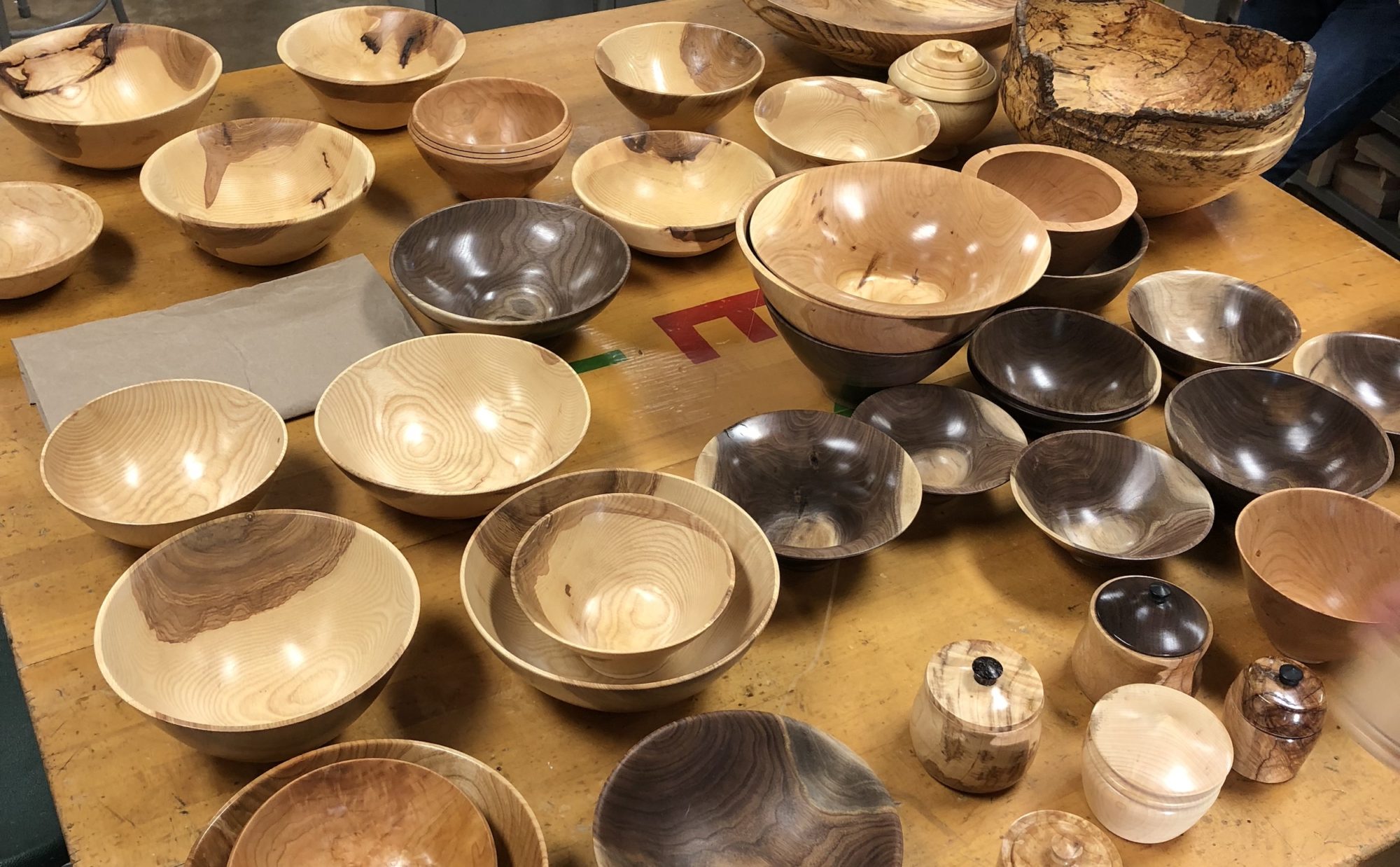Paul Demmert showed how 8 different finishes look on bowls made from the same wood and ranked and rated them on various attributes. His notes are below the meeting video.
The genesis of this presentation was a presentation the club had several years ago with Jim Finley talking about finishes. The idea that took root in my mind was to show a variety of finishes on bowls that were all the same kind of wood. This would allow a comparison among the different finishes.
About 1 year ago I got access to a large log of American Holly and that was an opportunity to build this presentation on the different finishes. American Holly, Ilex opaca, is a species of holly, native to the eastern and south-central United States, from coastal Massachusetts south to central Florida, and west to southeastern Missouri and eastern Texas. It is the state tree of Delaware. Ilex opaca is a medium-sized broadleaved evergreen tree growing on average to 10–20 m (33–66 ft) wide canopy, and up to 30 m (98 ft) tall. Typically, its trunk diameter reaches 50 cm (20 in), sometimes up to 120 cm (47 in). The bark is light gray, roughened by small warty lumps. The wood is very pale, tough, close-grained, takes a good polish, and is used for whip-handles, engraving blocks and also cabinet work. (specialty items such as fancy cabinet inlays, small pieces of furniture, brush backs, handles, novelties, wood engravings, scroll work, woodcuts and carvings, and measuring scales and rules for scientific instruments). Ideal lumber has a very uniform, pale white color with virtually no visible grain pattern. Janka Hardness: 1,020 lbf (red oak 1290, black walnut 1010, cherry 950)
Because Holly has such a subdued grain pattern, it takes coloring dyes very well. Because of this, Holly can be dyed black and used as a substitute for ebony–for piano keys, violin pegs, and fingerboards. Knots are common, which can reduce the usable area of the wood.
Holly is usually cut during the winter and kiln dried shortly thereafter to preserve the white color of the wood. Holly can develop a bluish/gray fungal stain if not dried rapidly after cutting and this will be evident on the bowls I have for this presentation, because I didn’t get the bowls turned until over 6 months after it had been cut down in the late summer to early fall.
I have turned holly once before and that was a tree that had been cut down at my Father-in-Laws house and my wife grabbed a couple of sections of that tree after it had been hauled off to the dump. I turned that holly green, right after Leslie got it home so the resultant bowls were pure white, with no visible grain, almost like porcelain. Again this holly was turned within a month of being cut down.
This wood came from a landscape company in Altoona. In the fall of 2021 I went to pick up the wood. It was a single log, 8 ft long, 12-14 in diameter. The worker helped me by cutting the log into sections that were 16-18 in long, weighing about as much as a single person could carry. I stored the sections in my basement and painted Anchor Seal on the ends of the sections to seal the end grain.
Later I cut the sections in half with my chainsaw, right down the pith, giving me 2 bowl blanks per section.
I turned all of the bowls from March 6 to April 9 2022. All of the bowls were turned green, with the foot of the bowls pointing to the bark part of the blank, the inside of the bowls oriented towards the pith or the center of the tree. These bowls were only turned once, air dried for about 5 months (from April to August), and hand-sanded. Note that my bowls are functional, rather than artistic—wall thickness is between 3/16 to 3/8 inch. There was some movement in the bowls during drying, but some bowls help their shape pretty well. None of the bowls were remounted for a second turning. I started finishing the bowls in late August and applied last coat in early October.
Finishes Used
#1 Shellac (1# cut) dewaxed super blonde flakes dissolved in denatured alcohol
#2 Total Boat Varnish Clear Gloss
#3 Minwax Polycrylic Clear Satin
#4 Minwax Spar Urethane Clear Gloss
#5 Behlen Mohawk Salad Bowl Finish Clear
#6 Watco Danish Oil
#7 Deft Brushing Lacquer
#8 Waterlox Original Tung Oil
Procedure
220 grit First coat
320 grit Second coat
400 grit Third coat
600 grit Fourth coat
Total coats of finish: 6 or more
Buffed with white pad = 0000 steel wool to knock off dust nibs
Results
Various differences between the finishes include how does it flow (drips, brush marks, drying time), the general appearance of the finish, the cost, and cleanup.
Flow
Finishes that flow nicely: shellac, Minwax Spar Urethane, Behlen Mohawk Salad Bowl, Watco Danish Oil, Deft Brushing Lacquer, Waterlox
Others: Total Boat Varnish and Minwax Polycrylic tended to be thick and left drips (better when thinned with water)
Deft Brushing Lacquer has levelling agents that almost eliminate brush marks.
Shellac, Total Boat Varnish, and Deft Lacquer dry very fast.
Watco Danish Oil very slow drying and stays tacky
General Appearance of the Finish
In this demonstration, I did not try to sand and buff out the bowls to make them perfect. Some of them still have brush marks and other defects in the finish that I need to address. I wanted to concentrate on the impression the finish makes on the viewer. This is very subjective. Also remember that results are dependent on the wood species—particularly if you are looking to see how much the tone of the wood has darkened after finish has been applied. This would not be a consideration if the bowls were turned from walnut, cherry, hickory, or other darker woods.
From my perspective #4, #3, #7 and #2 take on the “best” appearance, because these bowls still retain a lighter tone that is more consistent with the lighter color of Holly.
Bowls #6 and #8 come in at the end of the pack for the same reason—they darken the tone of the wood too much. Even though, #8 has a nice looking finish overall.
Cost
Most of the cost figures used in my analysis come from the prices I paid, either through Amazon or at local stores like Ace Hardware, Lowes, and Home Depot. If you took the time to shop around, you probably could beat the prices I paid.
#1 Minwax Spar Urethane Clear Gloss ($18.86/qt)
#2 Shellac (1# cut) dewaxed super blonde flakes dissolved in denatured alcohol (Flakes $2.20/oz, DNA $4.00/8 oz,= $24.80/qt Zinsser $26.53/qt)
#3 Watco Danish Oil ($24.99/qt)
#4 Deft Brushing Lacquer ($26.13/qt)
#5 Waterlox Original Tung Oil ($32.83/qt)
#6 Behlen Mohawk Salad Bowl Finish Clear ($40.45/qt)
#7 Total Boat Varnish Clear Gloss ($44.00/qt)
8 Minwax Polycrylic Clear Satin ($55.60/qt)
Cleanup
Water soluble: Total Boat Varnish, Minwax Polycrylic
Mineral Spirits: Behlen Mohawk Salad Bowl, Minwax Spar Urethane, Waterlox, Watco
Lacquer Thinner: Deft
Denatured Alcohol: Shellac


